The seasons cycle
spring flies in on the wings
of a mallard pair.
We have waited so long for the thaw,
but gazing into the eye of the window,
we see only the cold heart of winter.
The sky,
storm clouds spill over mountain tops
the hillsides,
hide behind curtains of snow flurries.
the trees,
buds burst only with hoarfrost
the fields
greening grasses trapped under dirty snow.
I want to turn away
from winter’s cold shoulder,
to pull the blinds and leave.
Instead I reach out a tentative hand
and lift the sash, steeling myself
against the blast of frigid wind.
In the sky
ka-ronk, ka-ronk , two geese now paired.
from the hillsides
hoo hoo hoodoo, horny great owls.
from the trees
kwik-kwik-kwikwikwikwik , laughter of mated flickers
from the fields
keeeeeeeer, a redtail hunts food for its young.
Together we stand at the window and listen.
Packing my camera for the ski trip to the Centennial Valley, I had one thing in mind. Mountains. Everyone has an affinity for a particular landscape. There are ocean people, like my husband, who look out on the ceaselessly undulating water and envision a magical world beneath, so independent of mankind, where exotic and strange creatures flourish. There are flatlanders who are happiest in big prairies where you never have to look up to see the sky, but only out to limitless vistas where any direction you turn is wide open possibility. There are forest people who love the cathedral like columns of tree trunks and the green leafy sky lights that enclose them.
And then there are mountain people. I am a mountain person and the Centennials are my sorts of mountains. Rising four thousand feet from the Centennial valley, they pierce the sky above nine thousand feet with their glacier-sculpted rugged slopes. I envisioned hours spent trying to capture their changing moods as the sun arced across their peaks, following their unique east/west orientation. On the fifteen mile snowmobile ride from Henry’s Lake to Elk Lake, the mountains towered over us, a promise of spectacular panoramas in the days ahead.
The next morning, however, 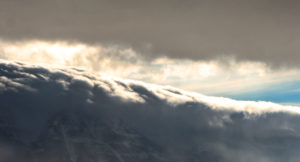 as I skied out toward the Red Rocks Wildlife Refuge, the mountains had disappeared. Banks of storm clouds avalanched from their summits and down their slopes. Rather than jagged ridgelines and snow crusted peaks, I was faced with what looked like a giant wave about to break on the valley floor. I am not unfamiliar with disappearing mountains. I went to college in Tacoma, Washington and it was four weeks into my first term before Mount Rainier appeared one morning as if by magic, looming through my dorm window.
as I skied out toward the Red Rocks Wildlife Refuge, the mountains had disappeared. Banks of storm clouds avalanched from their summits and down their slopes. Rather than jagged ridgelines and snow crusted peaks, I was faced with what looked like a giant wave about to break on the valley floor. I am not unfamiliar with disappearing mountains. I went to college in Tacoma, Washington and it was four weeks into my first term before Mount Rainier appeared one morning as if by magic, looming through my dorm window.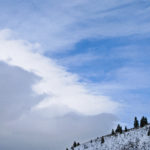
But I didn’t have four weeks. We were only going to be at Elk Lake for two days. The weather did not break. As I watched the sky for some sense the storm would move out, I began to really see the clouds. Not just that they obscured the mountains I wanted so badly to photograph, but I actually saw the clouds themselves, and the way they swept across the sky like brush strokes of paint, creating an ever changing abstract work of art over my head. I began to understand the attraction of the “big sky” which was more like a movie than the single-frame grandeur of the mountains.
 The world gave me clouds and so I photographed clouds, trying to capture just a hint of their ephemeral beauty. I realized you could never go somewhere with the plan to photograph clouds. All you could do was take advantage of the opportunity when it presented itself. After all, the mountains would always be there. Or not.
The world gave me clouds and so I photographed clouds, trying to capture just a hint of their ephemeral beauty. I realized you could never go somewhere with the plan to photograph clouds. All you could do was take advantage of the opportunity when it presented itself. After all, the mountains would always be there. Or not.
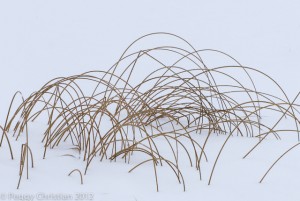 Many people see the reed and how it bends under the heavy burden of snow, or bows its branch tips to the ground in the rush of flood waters, how it sways whatever way the wind blows, and what they see is weakness, spinelessness, pliancy, a giving-in to the forces around it.
Many people see the reed and how it bends under the heavy burden of snow, or bows its branch tips to the ground in the rush of flood waters, how it sways whatever way the wind blows, and what they see is weakness, spinelessness, pliancy, a giving-in to the forces around it.
Unlike the tall, thick cottonwoods with their deeply corded trunks, the reed doesn’t reach above the canopy, doesn’t strive for great heights. But then, walking through the woods after a fierce wind or a raging flood and you find the massive root balls of the cottonwoods ripped from the soil, their root systems too shallow to hold against extremes in weather.The reeds though, put their energy into digging themselves deep into the earth with tangled intertwined root systems that hold against even the constant erosion of the river year.
Compassion is sometimes seen as weakness, a refusal to take a stand, to make a point, to prove the rightness of your stance. But too often a thrust of righteousness has shallow roots, too much energy out into reaching the heights of being right and not enough into digging deeper. Compassion is only weak if it too has shallow roots, does not stand in it’s deep truth, but bends too easily and lets itself be uprooted from its intuition and swept away.
There must be both–a fierce compassion with the ability to dance through change, but remain deep rooted in the ability to hold to the bank of self knowledge against the erosion of living.
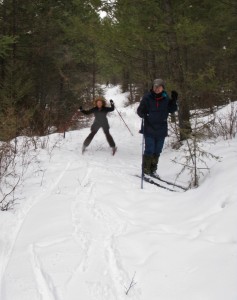 Another annual cookout at the homestead and as usual there were plenty of creative ideas for outdoor cooking. We began the day with a snowshoe trek up to the saddle and down the south side, looking for tracks and other sign. A few brave souls tried skiing on the crusty snow and got a bit of thrill careening down the narrow old road with tree hazards strategically placed. The upper meadow was smooth as white paper and for once we humans were the ones who left the story of our passing for other creatures to find.
Another annual cookout at the homestead and as usual there were plenty of creative ideas for outdoor cooking. We began the day with a snowshoe trek up to the saddle and down the south side, looking for tracks and other sign. A few brave souls tried skiing on the crusty snow and got a bit of thrill careening down the narrow old road with tree hazards strategically placed. The upper meadow was smooth as white paper and for once we humans were the ones who left the story of our passing for other creatures to find.
While we were skiing my son and his friend Grant, newly returned from Namibia where he’d spent two years in the peace corps, built a fire and got the tea water started. Grant mixed up a batch of barbeque biscuits and had the dough slowly rising by the side of the fire.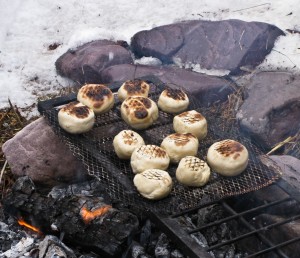
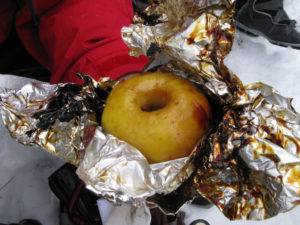 Packets of succulent concoctions simmering away soon covered the grill and coals. The usual mixed- grill dishes of meat and veggies in various combinations were the main course, but the deserts were what intrigued me. Judy made a baked apple, filling the cored center with brown sugar and cinnamon. Sharon split a banana lengthwise with the skin still on, then filled the center with peanut butter cups and melted it all slowly at the edge of the coals. Grant’s biscuits were slow to cook in the cold temperatures, but the crusty outsides and warm fluffy innards were delicious. When we are finished I threw Sharon’s banana peel on the fire and listened to it sing.
Packets of succulent concoctions simmering away soon covered the grill and coals. The usual mixed- grill dishes of meat and veggies in various combinations were the main course, but the deserts were what intrigued me. Judy made a baked apple, filling the cored center with brown sugar and cinnamon. Sharon split a banana lengthwise with the skin still on, then filled the center with peanut butter cups and melted it all slowly at the edge of the coals. Grant’s biscuits were slow to cook in the cold temperatures, but the crusty outsides and warm fluffy innards were delicious. When we are finished I threw Sharon’s banana peel on the fire and listened to it sing.
Looking forward to next year, I happened upon a great cookbook on a recent trip through Ennis. Titled Over a Fire: Cooking with a Stick and Cooking Hobo Style, it is filled with intriguing ideas and campfire lore. I’m planning to try the Fry Brownies made in hobo skillet. Check it out:
Fry Brownies
Before leaving home, stir together I cup flour, ¼ cocoa power, ¼ cup sugar, 1 tsp. baking powder, ¼ tsp. salt and 2 tbls. Nonfat dry milk. Add chocolate chips and walnuts if desired. Divide mixture among six zippered plastic bags, placing ½ cup of mix in each bag. Each bag will make 1 serving.
To prepare brownies, create a flat foil skillet. Find a sturdy Y-shaped forked stick and cut off the forked ends to matching lengths, 4” to 8” long. Cut two pieces of heavy- duty foil, extending 3” beyond the edges of the fork in all directions. Wrap foil tightly around the fork and joint. Use the skillet on a grate or tin can stove. (A portable frying pan was sometimes called a “banjo” in hobo terms.)
Place the pan over medium low coals or embers. To one bag of prepared brownie mix, add 1 teaspoon of vegetable oil and 1 ½ tbls. Water; knead mixture in bag until blended. Heat 1 tsp. oil in skillet. Cut off a large piece from one corner of plastic bag and squeeze spoon-sized mounds of brownie batter into hot skillet. Cook until bottoms are browned and tops are no longer shiny. Flip brownies over, flatten as needed and cook until other side is lightly browned. Let cool before serving.
Silent sentinel standing grounded, he does not take flight as I approach, but drills me with his jet black beady eye–sending all my petty thoughts and worries scattering like the wind blown trash skittering across the highway. I stare back, meeting his gaze unflinchingly and we both are riveted in a locked gaze.
I feel as if he is asking something of me, or more as if he is questioning me. How aware are you of the life pulsing all around you? Do you feel the shift in the breeze, the slight drop of temperature that precedes those clouds ready to spill down into the valley from the mountain ridges? Do you taste the tang of the wind that heralds snow?
Do you hear the sudden rush of wings and then their silent glide as the re-tail swoops down upon the too bold vole? Do you smell, barely discernible under the sharp smell of the snowy wind, the crushed green growth of the mullein leaves under your feet–that rosette of spring still frosty, but juicy with green?
Do you sense the pulsing, living world around you even in this desolate, cold landscape? The busy tunneling under fields? The roots of trees reaching deeper below the frozen surface? Or have you bundled yourself so tightly into your all- too-human concerns that you see nothing more than a ragged bird at the side of a dirty road?